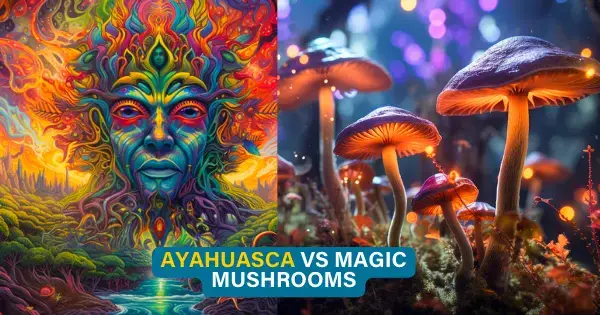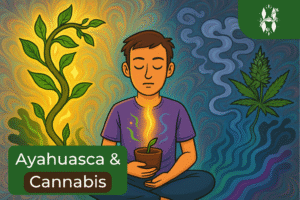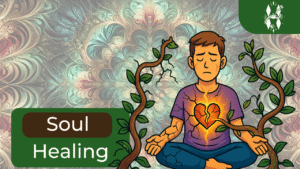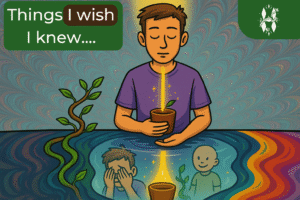This blog explores the nuances and commonalities of these two powerful ancestral medicines, Ayahuasca vs mushrooms, guiding you to better understand which might resonate more with your current stage of personal and spiritual development.
Introduction:
Ayahuasca, a traditional Amazonian plant medicine, or magic mushrooms, have their own rich history of use in various cultures. Both offer pathways to profound insights and transformations. Through this exploration, we’ll compare their effects, the context of their use, and the experiences they facilitate, providing you with a clearer picture of what each might bring to your journey of self-discovery and healing.
Key takeaways:
- Both magic mushrooms and Ayahuasca can create breakthrough experiences, understandings about our lives and be a profound catalyst for change in a person.
- It is important to do these medicines in a “set and setting” where one feels safe and is well taken care of. Ayahuasca is always conducted in a ceremonial context with experienced shamans / Taitas / facilitators which is a great benefit
- The purging is a tremendously powerful element of an Ayahuasca ceremony, which allows us to energetically let go of things that no longer serve us.
- In some ways mushrooms can be used in a more open, experimental way.
Table of Contents
Disclaimer:
Please note that Ayahuasca and magic mushroom ceremonies vary widely across different cultures and traditions. The information presented here is a broad perspective, but individual experiences can differ significantly based on the specific practices of the ceremony leaders and the setting.
Furthermore, while we offer a general outline of how Ayahuasca and mushroom ceremonies are typically conducted, remember that your personal experience can vary greatly.
There’s no definitive guide that can fully prepare you for the unique, subjective journey you will experience with either Ayahuasca or magic mushrooms. Therefore, it is crucial to communicate with your ceremony facilitators, ensuring they can address your questions and concerns.
Ultimately, the choice of which path to follow should be a personal decision, made after careful consideration and in alignment with your own spiritual and healing goals.
Similarities
Exploring the similarities between magic mushrooms and Ayahuasca reveals how both of these powerful substances serve as potent tools for deep introspection and self-discovery. At their core, both facilitate a profound journey into the subconscious, acting as mirrors that reflect the innermost aspects of our psyche.
When you engage with either magic mushrooms or Ayahuasca, you go on a journey that can illuminate various aspects of your life. These medicines can offer clarity on what you’re doing well and areas where you might be straying off your desired path.
They provide opportunities to understand and correct personal missteps, helping to align your actions more closely with your true intentions and values.
One of the most significant aspects of both experiences is the ability to access and feel suppressed emotions. This emotional unearthing can be intense, but it is often necessary for healing and growth.
Both magic mushrooms and Ayahuasca can act as catalysts for confronting and processing unresolved issues and traumas that continue to influence your present life.
Additionally, these psychedelics can provide a stark reality check, offering a clear-eyed view of your life as it is, unclouded by the habitual narratives we tell ourselves. This unvarnished truth can be challenging, but it is often a crucial step towards making meaningful changes.
Both magic mushrooms and Ayahuasca also have the potential to impart visions or insights about the future, helping to shape a vision for the life you aspire to live. This forward-looking aspect can be incredibly empowering, providing direction and motivation for personal and spiritual development.
Origins of Ayahuasca and Magic Mushrooms:
The origins of Ayahuasca and magic mushrooms are as rich and diverse as the experiences they offer. Understanding where these medicines come from adds depth to our appreciation of their roles in various cultures and traditions.
Ayahuasca, with its roots deeply linked to the Amazon rainforest, has been a cornerstone of spiritual and healing practices among indigenous tribes for centuries. It is revered for its profound healing properties. It plays a significant role in the cultural fabric of Amazonian tribes, being used in rituals and ceremonies for spiritual guidance, community bonding, and medicinal purposes.
Magic mushrooms, on the other hand, boast a more global heritage. These fungi have been used in spiritual and healing contexts across many different cultures and regions. Perhaps the most well-known traditional use of magic mushrooms is in Mexico, particularly among indigenous groups like the Mazatec, Mixtec, Nahuatl, and Zapotec. These regions have a long history of using psilocybin mushrooms (the psychoactive compound found in magic mushrooms) in their religious rituals, healing practices, and ceremonies.
The use of these mushrooms in such contexts is often guided by shamanic figures, who help navigate the spiritual journey and ensure the safety and wellbeing of participants.
Both share a common thread of being deeply respected and carefully used within their respective cultural contexts, highlighting their importance as tools for spiritual exploration and healing.
Must read Blog: Ayahuasca origin – how the indigenous discovered Ayahuasca
Differences between Ayahuasca vs magic mushrooms
One key difference between Ayahuasca and magic mushrooms lies in their accessibility and the contexts in which they are typically used.
Accessibility:
Magic mushrooms have the advantage of being relatively easy to cultivate at home, making them more accessible to a broader audience. This accessibility means that, with some effort and knowledge, individuals can grow their own mushrooms for personal use.
It’s important to note, however, that the cultivation and possession of magic mushrooms are subject to varying legal restrictions across different regions. While we don’t encourage any illegal activity, the fact remains that obtaining mushrooms can be more straightforward compared to Ayahuasca.
Ayahuasca, in contrast, is much harder to come by, especially in Western countries. Its preparation involves specific plants from the Amazon rainforest and a process that requires traditional knowledge and experience. This complexity, coupled with legal restrictions in many parts of the world, makes Ayahuasca less accessible than magic mushrooms.
Purpose and Context of Use:
Another notable difference lies in the typical contexts and purposes for which these substances are used. Magic mushrooms have a dual role in both recreational and ceremonial settings. Recreationally, they are often used for enhancing experiences like festivals, music events, or nature hikes.
This recreational use is largely due to the often euphoric and perceptually enhancing effects of psilocybin, the active compound in magic mushrooms.
However, magic mushrooms are also increasingly being used in ceremonial contexts, similar to Ayahuasca. When approached with intention and respect, mushrooms can facilitate profound spiritual and emotional insights.
The setting and mindset (often referred to as “set and setting”) play crucial roles in defining the experience. A ceremonial context, often guided by experienced facilitators, can create a safe and supportive environment for deeper exploration and healing.
Potential dangers of magic mushrooms:
One risk with magic mushrooms arises from their use in casual, non-ceremonial settings. Imagine taking mushrooms with friends for a light-hearted activity like playing card games.
Without much initial effect, you might be tempted to consume more, only to find yourself suddenly plunged into an intense, unexpected confrontation with deep-seated issues, like a past childhood trauma. In such a setting, neither you nor your friends may be prepared to handle the emotional and psychological intensity of this experience.
This scenario often leads to what is described as a ‘bad trip’ — a situation where a seemingly recreational activity takes a serious turn, confronting you with personal challenges or traumas.
Another example is the story of a girl who took mushrooms at a party and ended up locking herself in the bathroom for five hours.
During this time, she came to a profound realization about being in a toxic relationship and subsequently found the strength to end it. While the outcome was ultimately beneficial and led to a necessary life change, the setting—a party environment—was far from ideal for such a profound and challenging experience.
The Benefit of Ceremonial Context:
In contrast, when these medicines are taken in a ceremonial context, there’s a different set of expectations and preparations. Participants are generally more open to exploration and self-discovery, and challenging experiences are often viewed as valuable parts of the spiritual journey.
In these settings, difficult revelations are seen as opportunities for growth and healing, with the support of experienced facilitators and a nurturing environment.
Ayahuasca, in particular, is almost exclusively used in ceremonial settings. This practice ensures that participants are prepared and supported throughout the experience, minimizing the risk of unexpected, overwhelming encounters.
The ceremonial context provides a safe space where participants can confront deep-seated issues and work through them with guidance and support.
Must read: Blog: What to expect in an Ayahuasca ceremony
Why pay thousands of dollars to travel to South America and pay for an Ayahuasca retreat?
When considering the choice between traveling to South America for an Ayahuasca ceremony and taking magic mushrooms closer to home, several factors come into play, highlighting the unique aspects of an Ayahuasca experience.
Guidance of a Shaman or Taita:
One of the primary advantages of participating in an Ayahuasca ceremony is the presence and guidance of a shaman, or Taita. These individuals are not just facilitators; they are seasoned experts in navigating the spiritual and emotional realms induced by Ayahuasca.
They possess a deep understanding of how to manage the ceremony and provide what participants need at various stages of their journey. A shaman knows when to offer support, when to allow space for personal exploration, and how to foster an environment conducive to healing and discovery.
This expert guidance is invaluable, especially when navigating the intense and often unpredictable nature of Ayahuasca.
Must read Blog: Ayahuasca Retreat Cost – finding a fair price for healing
The Benefits of Purging:
Purging, often associated with Ayahuasca, is typically seen as an unpleasant but necessary part of the experience. However, its significance goes beyond mere physical cleansing. Purging during an Ayahuasca ceremony is not just a physical release; it’s a profound spiritual and energetic cleansing process.
The act of vomiting, far from being a negative aspect, is actually a crucial and beneficial part of the Ayahuasca journey. It represents the release of negative energies and emotional blockages, facilitating a deeper level of healing and understanding.
In the end, life is simple: do the things that are good for you and leave out the things that are bad for you. And we even know what is good for us and what is bad for us. But for whatever reason, we also keep doing the things that are bad for us (we even know it). It is because there are dense, lower vibrational energies within us which are drawn to those activities.
Once you start to clean those energies within you, you will be less drawn to those activities and more drawn to the activities that are good for you, and your life will automatically improve.
Must read blog: Ayahuasca vomit explained – why you vomit on Ayahuasca
Self-Regulation and Navigating the Journey through the purge
Another unique aspect of Ayahuasca is its self-regulating nature, especially in comparison to other psychedelics like mushrooms or LSD.
On Ayahuasca, if you start spiraling down a negative or challenging path, the act of purging can serve as a physical manifestation of your body and mind’s rejection of these harmful patterns.
It’s a way of stopping the negative spiral, clearing your system, and resetting your thought patterns. This self-regulation helps prevent the kind of endless negative loops that can sometimes occur with psychedelics like mushrooms, where such a physical feedback mechanism is absent.
In summary, while taking mushrooms in a comfortable and familiar setting may seem appealing, the unique benefits of an Ayahuasca ceremony, from the guidance of a shaman to the cleansing process of purging, offer a different and deeply transformative experience.
These elements work together to create a safe, supportive, and profoundly healing environment, enabling a journey of self-discovery and growth that is distinct from what other psychedelics can provide.
If you want to experience Ayahuasca for yourself, we encourage you to check out our Ayahuasca Retreat Center in Colombia.
Find out if Ayahuasca is right for you
- Will you be safe physically and emotionally?
- How will you be supported in the ceremony?
- How do the facilitators handle difficult situations?
- How will you be able to process the experience?
- You want change, but will your life be unrecognizable after Ayahuasca?
+ 13 things to consider before drinking Ayahuasca?
Intensity of the experience:
Navigating the intensity of psychedelic experiences with Ayahuasca and magic mushrooms reveals a spectrum of subjective experiences, influenced by various factors including dosage, individual sensitivity, and mindset.
Comparative Intensity:
There’s a common perception that Ayahuasca represents the peak of psychedelic experiences, often regarded as the most intense or the ‘final boss’ of psychedelics.
This view suggests that successfully navigating an Ayahuasca journey is a profound act of self-conquest. Indeed, for many, Ayahuasca does present a more intense experience than magic mushrooms, both physically and spiritually. However, this is not a universal rule and depends greatly on the individual’s unique response to the medicine.
Taking a ‘hero dose’ of mushrooms, generally considered to be upwards of 5 grams, can lead to an exceptionally intense experience, perhaps even more challenging than a typical Ayahuasca journey. The intensity of a psychedelic experience is not only defined by the substance itself but also by the quantity taken and the individual’s personal and psychological makeup.
Individual Connections:
There are individuals who may not feel a strong connection with Ayahuasca, and for them, the mushroom experience might be more profound.
It’s important to recognize that even if one doesn’t feel an immediate or strong connection with Ayahuasca, the experience can still offer significant benefits, potentially unfolding its effects over time.
Physical and Peak Experiences:
Physically speaking, Ayahuasca is more intense due to the purging it induces, a phenomenon less common with mushrooms. Ayahuasca can create a sensation where the body feels ‘deactivated,’ allowing the medicine to work more deeply on the spirit.
Regarding the peak moments of the experience, they tend to be relatively brief in mushroom ceremonies, typically lasting around 20 to 30 minutes. It’s more common for the peak intensity to sustain for a longer duration with Ayahuasca than with mushrooms.
In conclusion, while Ayahuasca is generally perceived as the more intense experience, both physically and in terms of the depth of the journey, this is a subjective matter.
The experiences vary widely from person to person, influenced by individual sensitivities, the ceremonial context, and personal interpretations of the experience. It’s this variability that makes each psychedelic journey unique, profound, and challenging in its own right.
Cannabis and its influence on mushroom vs. ayahuasca ceremonies:
Exploring the relationship between different plant medicines, such as cannabis and mushrooms, and their compatibility with Ayahuasca offers insight into the diverse ways these substances can interact and affect your experiences.
Cannabis and mushrooms:
Cannabis and magic mushrooms can be a compatible combination, particularly for those who are seasoned in their use. Experienced cannabis users often find that incorporating cannabis into their mushroom journey can amplify the intensity and depth of the experience.
The synergistic effect of these two substances can enhance the sensory and psychedelic effects of mushrooms, leading to a more profound journey. However, it’s important to approach this combination with caution, as the intensification isn’t always predictable and can vary greatly depending on the individual’s tolerance, mindset, and environment.
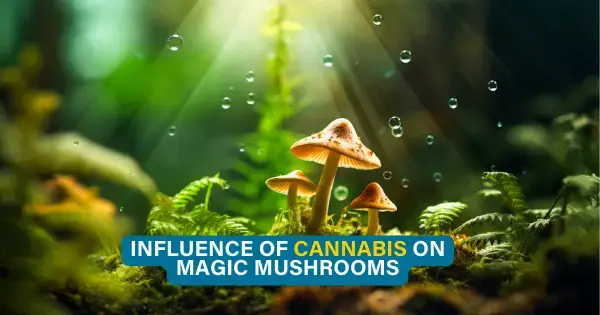
Ayahuasca and Cannabis:
The combination of Ayahuasca and cannabis, on the other hand, is traditionally viewed as incompatible. Most indigenous cultures and experienced Ayahuasca practitioners advise against mixing these two plant teachers.
An exception to this general rule is found in the practices of the Santo Daime church, which integrates both Ayahuasca and cannabis in their ceremonies. However, this practice is not part of the indigenous heritage of Ayahuasca and is relatively modern.
Given the complexity and intensity of Ayahuasca experiences, combining it with cannabis, especially for those not within the Santo Daime tradition, is generally not recommended. The unpredictability of this combination can lead to overwhelming experiences.
Differences in the ceremonies
The ceremonial practices surrounding Ayahuasca and magic mushrooms significantly differ, reflecting the distinct nature of each psychedelic experience.
Ayahuasca vs magic Mushrooms Ceremonies:
In Ayahuasca ceremonies, the emphasis is typically on an introspective journey. Participants are often encouraged to’sit with the medicine,’ immersing themselves in a deep internal exploration.
This setting is designed to facilitate a profound engagement with the subconscious, allowing individuals to face and process their innermost thoughts, emotions, and experiences. While there are exceptions where conversation can be a part of the healing process, these instances are relatively rare.
The general atmosphere in an Ayahuasca ceremony is one of quiet introspection, with participants often remaining seated or lying down throughout the experience, deeply immersed in their personal journeys.
Conversely, mushroom ceremonies tend to offer a more open and flexible structure. Conversations during these ceremonies can occur more freely and naturally, potentially forming an integral part of the experience.
These interactions can range from light-hearted chats to profound exchanges, depending on the participants’ needs and the facilitator’s guidance. However, it’s important for facilitators to monitor these conversations, ensuring they contribute to, rather than distract from, the introspective journey.
Sometimes, talking can serve as a diversion from confronting deeper internal issues, especially if it leans more towards idle chatter than meaningful dialogue.
In terms of musical accompaniment, mushroom ceremonies often feature a wider variety of music played, sometimes even through speakers. This can include not only traditional medicine music but also more contemporary genres like upbeat or techno tunes or classical music.
This diversity in music choice reflects the more experimental and expressive nature of mushroom ceremonies, where self-expression and exploration are given more space.
Different ways of teaching
The teaching styles of plant teachers like Ayahuasca and magic mushrooms are distinct, each offering unique approaches to imparting wisdom and facilitating healing.
Mushrooms and Laughter
Magic mushrooms often teach through laughter, a powerful tool for healing and transformation. In a group setting, this effect can be amplified, with the contagious nature of laughter creating a shared experience that fosters connection and release.
Laughter in the context of a mushroom ceremony can serve as a cathartic release, helping to break down barriers and offering a light-hearted pathway through which profound insights can emerge. It’s a way of navigating and making sense of life’s challenges, allowing participants to approach their issues with a sense of lightness and perspective.
Ayahuasca and Crying:
Conversely, Ayahuasca tends to teach more through the process of crying. This intense plant medicine often guides participants into deep introspection, where they confront and process unaddressed emotions. The act of crying during an Ayahuasca ceremony can be a powerful release, a physical manifestation of letting go of buried pains and traumas.
It’s a form of deep emotional cleansing, allowing participants to fully feel and thus be liberated from their suppressed emotions. This intense emotional release often leads to profound healing and a sense of renewal.
Varying subjective, individual experience
While these tendencies are observed in general, it’s important to note that emotional experiences in psychedelic ceremonies are not binary. Participants can and do experience a range of emotions in both types of ceremonies.
One might find themselves laughing during an Ayahuasca ceremony or crying during a mushroom journey. However, the propensity for laughter in mushroom ceremonies and crying in Ayahuasca ceremonies highlights the different ways these plant teachers work.
spiritual representation of the (plant) teachers
Exploring the spiritual representation of plant teachers like mushrooms and Ayahuasca reveals the profound and unique energies they embody, guiding us in distinct ways on our spiritual paths.
Mushrooms: The Playful Spirit
Mushrooms are often affectionately referred to as “Niños Santos” or “Holy Children.” This designation reflects their playful and sometimes mischievous energy, which can be both enlightening and challenging.
Engaging with mushrooms often feels like reconnecting with one’s inner child, tapping into the joy, wonder, and uninhibited curiosity that we often lose in adulthood. This connection can be deeply healing, allowing individuals to rediscover the simplicity and pleasure of life, often buried under the weight of daily responsibilities and societal expectations.
Additionally, many describe the energy of mushrooms as cosmic, suggesting a connection to broader, universal truths and a sense of oneness with the greater cosmos.
Ayahuasca: The Grandmother Spirit
In contrast, Ayahuasca is frequently described as embodying a grandmother spirit—wise, nurturing, yet stern when necessary. This characterization points to a sense of ancient wisdom and deep understanding that Ayahuasca is believed to possess.
The grandmother-spirit metaphor highlights the respect and reverence that Ayahuasca commands. Approaching Ayahuasca typically requires thorough preparation, both physically and spiritually, indicative of the profound and often intense journey it facilitates.
This preparation is not just about respecting the plant teacher but also about readying oneself to receive and integrate the deep teachings and insights that Ayahuasca offers.
Respect for the Plant & Fungi Teachers
While the energies of mushrooms and Ayahuasca are distinct—one more playful and cosmic, the other more ancient and wise—both demand a level of respect and intentionality.
Engaging with these teachers is not merely a recreational endeavor but a profound spiritual journey that can bring significant insights, healing, and transformation.
The different spiritual representations of mushrooms and Ayahuasca highlight the diverse ways in which these plant medicines can guide us, offering varied paths to understanding ourselves and the world around us.
Must read Blog: Ayahuasca vs San Pedro
Must read Blog: Ayahuasca vs Bufo
Self-Administering Ayahuasca vs. Magic Mushrooms:
Self-administering Ayahuasca carries significant risks, including severe physical dangers like suffocation from vomiting. Due to the intense and often unpredictable nature of Ayahuasca, as well as its profound physical effects, it’s strongly advised to partake in Ayahuasca ceremonies only under the guidance of experienced facilitators.
On the other hand, self-administering mushrooms is generally considered more manageable and safer. If you choose to take mushrooms by yourself, it’s vital to start with small doses and gradually increase as you build trust and confidence in the spirit of the mushrooms.
Creating a safe and comfortable environment is key; being in nature can be particularly conducive, as it allows for a sense of connection and relaxation. It’s also crucial to minimize potential distractions or interruptions; turning off your phone can help maintain the sanctity of your experience and prevent unwanted disturbances.
Microdosing Mushrooms:
Microdosing mushrooms has gained popularity for its benefits in enhancing creativity, mood, and cognitive function. The practice typically involves taking a very small dose of mushrooms—a fraction of what’s considered a psychoactive dose—every other day for a period, often recommended as 30 days.
This regimen can be extended to another 30 days if needed, but it’s important to approach microdosing as a temporary tool rather than a continuous habit.
The reason for this caution is that the heightened sense of vitality and alertness often experienced during microdosing can become a new normal, making regular life without microdoses seem less vibrant or engaging.
To avoid this dependency, it’s recommended to have extended breaks, waiting a year or more before another microdosing cycle. This approach ensures that microdosing remains a tool for specific periods of personal growth or cognitive enhancement, rather than a constant crutch.
In summary, while mushrooms can be self-administered and microdosed with a degree of safety, Ayahuasca requires a structured, guided environment. For both substances, responsible use, appropriate dosing, and a respectful approach to these powerful plant medicines are crucial for a safe and beneficial experience.
Conclusion: What medicine should I choose, magic mushrooms or ayahuasca?
As we’ve journeyed through the realms of Ayahuasca and magic mushrooms, we’ve uncovered the distinct characteristics, uses, and cultural contexts of these powerful plant medicines.
Ayahuasca, with its deep roots in the Amazonian spiritual tradition, offers a guided and intensely introspective experience, traditionally under the watchful eye of experienced shamans.
Magic mushrooms, accessible and versatile, provide both recreational and ceremonial pathways, allowing for personal exploration in various settings.
The choice between Ayahuasca and mushrooms depends on individual needs, intentions, and circumstances. While Ayahuasca demands a structured environment and a deep commitment to facing one’s inner self, mushrooms offer a more flexible approach, suitable for a range of experiences, from introspective journeys to social, communal settings.
It’s important to approach both Ayahuasca and mushrooms with respect, understanding their potential for profound psychological and emotional impact. Whether seeking healing, self-discovery, or spiritual growth, these plant medicines can be powerful allies on your journey, provided they are used responsibly, in safe and supportive environments.
FAQs:
What are the main differences between Ayahuasca and magic mushrooms?
The main difference between Ayahuasca and mushrooms is that mushrooms are fungi, and Ayahuasca is a mix of two different plants. Also, purging is a much more frequent occurrence after drinking Ayahuasca than after taking mushrooms.
Another aspect is the intention with which these medicines are approached. With Ayahuasca, it is always in a ceremonial context, while it is also common to use mushrooms in a recreational context.
Should I do ayahuasca or magic mushrooms first?
Only you (or your heart) knows if you should do Ayahuasca or magic mushrooms first. There are benefits to starting with either one. The benefit of starting with.
Ayahuasca means that you partake in a ceremony from the very beginning, and you are taken care of by people who know what they are doing. So if you have the courage to start with Ayahuasca, that is great. Especially with all the sensationally driven viral stories on the internet, there are many extreme stories that create a certain level of fear around Ayahuasca (which is not an accurate description). However, if one is not yet ready to start with
Ayahuasca, mushrooms can also be a great way to build that connection with oneself.
